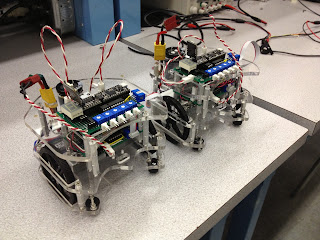_____________________________________________________________________________
- Back it up
- What exactly is a UAV?
- Next time...
_____________________________________________________________________________
Back It Up
Last week we went over a little of my background to explain my motivations, and we set down a 'mission statement' defining the purpose of this UAV program. In the Next Time... section I said we would look into the current UAV market as we start to define the requirements for our clean sheet bird. However, I'm going to divert from that plan for this week's post. Instead, we'll back up slightly to talk about something much more fundamental...
What exactly is a UAV?
Given that you're reading this blog, you probably already have some knowledge of UAVs. But since this term is so central to the work we're doing here it's important that we start out on the same page. So for the sake of consistency, let's begin at square one: 'UAV' is an acronym that stands for
Unmanned
Aerial
Vehicle
The field is rapidly expanding, as we'll discuss next week, so the terminology hasn't yet settled. Manufacturers are trying to differentiate their products, and operators are trying to distinguish their applications, so you might also hear a variety of terms like Unmanned Aircraft (UA), Unmanned Aerial System (UAS), Unmanned Combat Aerial Vehicle (UCAV), Rotorcraft UAV (RUAV), Micro-UAV (MUAV), Remotely Piloted Aircraft (RPA), Optionally Piloted Vehicle (OPV), drone, quadrotor, etc.
While the details might differ, all of these terms are getting at the same thing: a machine that flies without humans on board. Eliminating those constraints opens up a dizzying array of possibilities. At the large end of the spectrum, the definition tends to be fairly intuitive. Many resemble conventional aircraft, minus the space and life-support features normally devoted to a flight crew.
I would add one more quality as a 'nice to have': autonomy. A UAV can be thought of as a flying robot (as terrifying as that might sound to some) that can sense and interact with its environment, within the confines of its programming. This can be as simple as an autopilot, that keeps the aircraft flying straight and level without additional inputs, or it could include such high level tasks as total mission independence. While part (1) of the Mission Statement sets the bar at engineering and building a UAV, I am already hoping and planning to achieve this higher level sophistication. This isn't an end unto itself, but I suspect it will arise from creating an aircraft with capabilities that push the envelope.
While the details might differ, all of these terms are getting at the same thing: a machine that flies without humans on board. Eliminating those constraints opens up a dizzying array of possibilities. At the large end of the spectrum, the definition tends to be fairly intuitive. Many resemble conventional aircraft, minus the space and life-support features normally devoted to a flight crew.
 |
| Top: The now iconic MQ-9 Reaper. Bottom: The MQ-8 Fire Scout. |
Some large UAVs have taken on novel form factors, particularly in the High Altitude Long Endurance (HALE) category. For instance, as far back as 1995, NASA developed and flew the solar-powered Pathfinder UAV, which ultimately reached an altitude of over 80,000 feet. Without the need for pilots, similar aircraft will eventually achieve indefinite endurance, landing only for periodic maintenance.
| NASA Pathfinder solar powered UAV |
Whether or not they resemble 'typical' manned aircraft, these large UAVs are all highly engineered, sophisticated machines. At the smaller end of the spectrum, the definition gets a bit murkier. Is there a difference between a (micro) UAV and a model airplane? A toy?
I would contend there's a useful distinction to be made based on the complexity and utility of the aircraft. At the extremes, a simple, useless aircraft would not be a UAV and a sophisticated, useful aircraft would.
Toys exist at the low end of both spectra, since little engineering goes into their design. Toy manufacturers figure out how to inexpensively mass produce something that will fly, and take it to market. While it can be great fun to fly these around your living room, their performance is universally lacking, and it does no useful 'work'.
 |
| A quadrotor toy. |
RC (radio controlled) aircraft start to blur the boundary with UAVs as they have moderate complexity and low utility. Significantly more thought goes into their design than that of toys, and the result is a vastly superior aircraft. As you can see in the video below, RC helicopters are capable of maneuvers unthinkable in a manned aircraft, and unattainable by a toy. However, since these aircraft lack utility and subsystems that aren't strictly required for flight, they still fall short of the UAV mark.
RC helicopter performing incredible aerobatics.
To qualify as a UAV in my book, the aircraft must have been engineered to perform at least one task, and preferably have been designed with versatility in mind. To achieve that utility invariably requires a considerable amount of sophistication in both the design process and the final product. The result might be visually indistinguishable from an RC aircraft, as is the case for the RQ-11 Raven. However, this small aircraft is capable of 60-90 minutes endurance while carrying sensor payloads such as a stabilized gimbaled EO IR (Electro-Optical InfraRed) camera. This capability has helped it earn its place as the most widely used UAV in the world.
 |
| A soldier hand-launching the RQ-11 Raven. |
Next time...
...we'll rejoin the detour and discuss the current state of the UAV market, both in terms of common and anticipated uses, as well as available aircraft.
Until then...over and out.
_____________________________________________________________________________
Feel free to comment! I'd say all feedback is appreciated, but this is the internet, so keep it civil...




